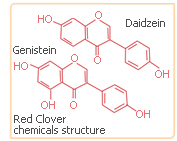How Red Clover Works
Red clover was considered by the Romans, Greeks, and Celts to be a sacred clover plant that brought good luck. Considering the many uses red clover has, one can say that the ancient peoples were right to believe that this herb had magical powers. Red clover has numerous uses and is beneficial to humans, animals, the soil, and even bees.
The basis for ancient peoples� belief in the healing power of red clover is based on the plants� medicinal properties, which are looked at in more detail below.
Isoflavones and Food
The organic compound: Isoflavones can also be found in many foods such as soybeans.
Properties of Red Clover
The scientific name for red clover is Trifolium Pratense. The plants� main benefit for humans is its high content of isoflavones; an organic group of compounds that can replace human hormones with plant hormones. Some isoflavones such as genistein act as an antioxidant and Atherosclerosis.
 Red clover seeds also have a high protein count (thirty-five percent) and contain many nutrients. These include several vitamins (to name a few: A, B, C, E and K) which are essential for the growth and maintenance of cells, tissues, and organs. Furthermore, the red clover seed contains several amino acids, which are the building blocks of proteins. Red clover also contains minerals such as: Red clover seeds also have a high protein count (thirty-five percent) and contain many nutrients. These include several vitamins (to name a few: A, B, C, E and K) which are essential for the growth and maintenance of cells, tissues, and organs. Furthermore, the red clover seed contains several amino acids, which are the building blocks of proteins. Red clover also contains minerals such as:
. Magnesium
. Calcium
. Potassium
. Chromium
Clinical trials have shown that phytoestrogenic herbs interact with the human body in different ways. These are discussed below.
How Does Red Clover Work With the Body?
 Red clover contains high levels of isoflavones - an organic group of compounds - which mimic estrogen. As a phytoestrogenic herb, red clover replaces lost natural hormones with artificial ones. This is beneficial to menopausal women suffering from hormone imbalance. Red clover contains high levels of isoflavones - an organic group of compounds - which mimic estrogen. As a phytoestrogenic herb, red clover replaces lost natural hormones with artificial ones. This is beneficial to menopausal women suffering from hormone imbalance.
However, the addition of artificial hormones also carries with it dangerous side effects.
Red clover contains a chemical compound known as coumarins which is capable of thinning and purifying the blood of mammals.
Despite these side effects, red clover is still widely used around the world to treat a variety of health problems. Continue reading to learn more about how red clover is used.
Conclusions about Red Clover
Red clover is great for treating some symptoms of menopause, but as a phytoestrogenic herb it can cause a number of harmful side-effects . Red clover has been criticized because it can interfere with the treatment of breast cancer.
Other alternative treatments are just as effective as red clover, but without the side effects. Non-estrogenic herbs, for example, are a great option for treating menopause symptoms. Read more in the following article.
Which herb should women try? Today women are looking for relief from their menopause symptoms with herbs. Phytoestrogenic herbs and non-estrogenic herbs are good in relieving menopause symptoms, but recent studies show that non-estrogenic herbs have no side effects because they help the body to produce its own hormones instead of introducing hormones like the phytoestrogenic ones. Learn more about non-estrogenic herbs for menopause.
| 

